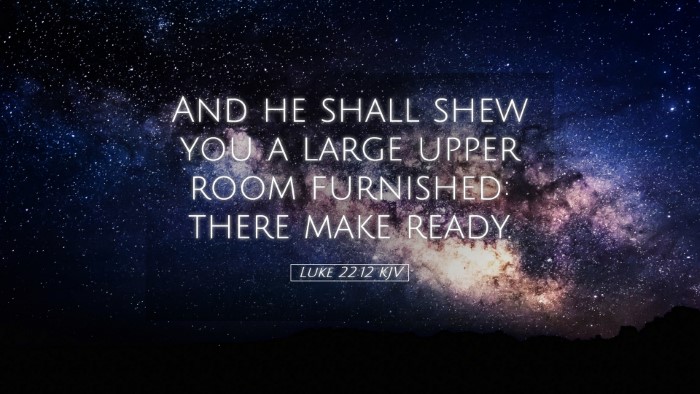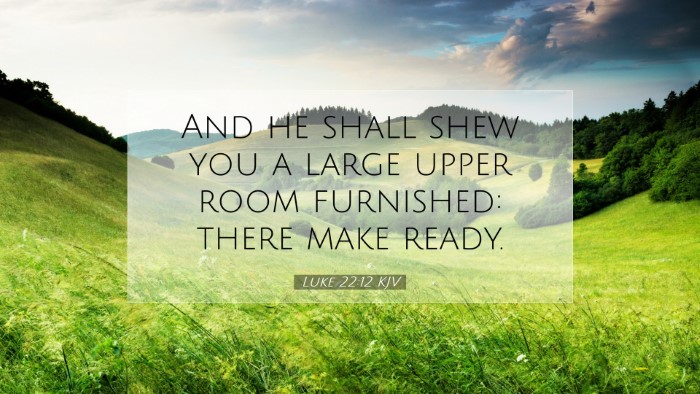Commentary on Luke 22:12
Luke 22:12 (KJV): "And he shall show you a large upper room furnished: there make ready."
Context and Significance
The passage occurs during the time of the Last Supper, a pivotal moment in the Gospels. Jesus prepares His disciples for the imminent events of His Passion, and this preparation involves not only the spiritual but also the logistical. This moment reflects the profound organization and foreknowledge of Christ, as He arranges for an intimate gathering away from the prying eyes of those seeking to harm Him.
Insights from Commentaries
Divine Provision and Direction
Matthew Henry emphasizes the divine appointment in this scenario. The directions given to the disciples reflect God's providential care and plan. It is instructive that the disciples are informed about the location and the furnishings of the room, suggesting that God has prepared a place for them at such a crucial time.
"The place was not chosen by chance, but was foreordained by Christ. It was reserved for this great occasion; a testament to the orchestration of events surrounding His death and resurrection." - Matthew Henry
Readiness of the Upper Room
Albert Barnes draws attention to the significance of the "large upper room" being furnished. This detail is not merely logistical but symbolizes the readiness to receive the sacrificial meal that Jesus was about to share with His disciples. It denotes a space consecrated for spiritual reflection and communion, highlighting that sacred moments often occur in dedicated places.
"The furnished upper room sets a scene of comfort and preparation. It is more than mere accommodation; it is a sacred space for crucial theological and relational exchanges." - Albert Barnes
Symbolism of the Feast
Adam Clarke expounds on the rich symbolism inherent in the Last Supper, explaining how the furnished upper room serves as more than just a gathering place. It becomes a symbol of fellowship and the impending new covenant. The upper room setting emphasizes the elevation of the moment above the earthly realm, metaphorically setting the stage for transcendent truths to unfold.
"Herein lies the beginning of the new covenant in Christ’s blood. What transpires in this upper room would shape the course of Christian worship for centuries." - Adam Clarke
Theological Reflections
The Preparation for Sacrifice
This verse encapsulates the essential act of preparation for the sacrificial act of Christ. The arrangements made for the meal signal the transition from Old Testament rituals to the New Covenant, whereby Christ now serves as the ultimate Lamb. Such provisions reflect the deeper theological reflection that God does not merely call individuals into a relationship without first preparing them for what that might entail.
- Expectation of the Messiah: The preparations for the feast not only denote physical readiness but also the fulfillment of Messianic expectations.
- Personal Invitation: The act of showing a specific place highlights individual disciples' understanding and personal relationship with Christ.
Lessons for the Church Today
This passage offers critical lessons for contemporary believers. The nature of ecclesial preparation, stewardship of sacred moments, and creating spaces for communal worship are paramount. As pastors and theologians reflect on this, they may consider how their churches prepare for significant spiritual milestones.
"The desire to institute a sacred meal in a sacred space resonates today. Churches should continually seek to curate environments where spiritual feasting can occur." - Theological Reflection
Conclusion
Luke 22:12 serves as a profound reminder of the divine orchestration behind key moments in Christian history. The preparation for the Last Supper illustrates God's providential care, the importance of sacred spaces, and the transformative nature of Christ’s impending sacrifice. As leaders and scholars engage with this text, they are encouraged to consider its implications for faith communities and individual lives alike.


